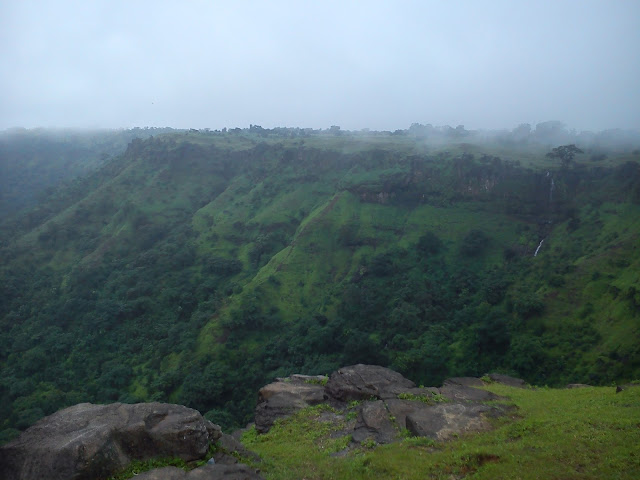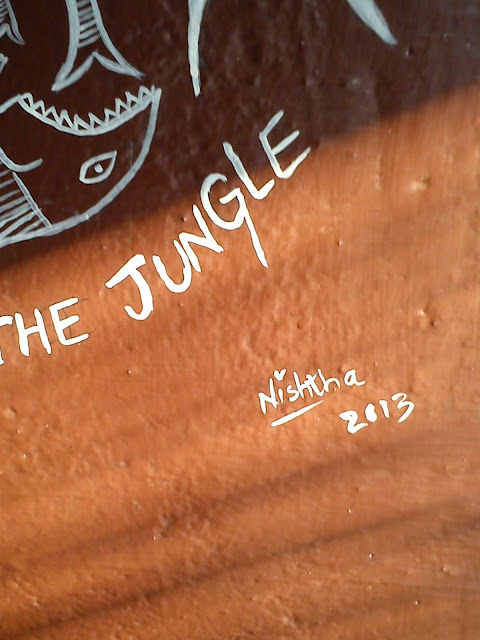Today, I bore witness to something so elegant, so wondrous, so intellectually appealing, and so powerful, that putting it into words is not ever giving it enough justice. I am blessed to have seen a Goddess - Mallika Sarabhai - perform the most wonderful theater act that I have ever seen.
Lucky that Nishtha read the newspaper today and found out that Mallika Sarabhai was performing today at her family's own, the Natarani Theatre, at the Darpana Academy of Performing Arts (DAPA). Established by her mother, the famous danseuse Mrinalini Sarabhai, and her father, the Father of Indian Space Program, Vikram Sarabhai in 1949, the DAPA is a school for performing arts in Ahmedabad; its departments ranging from performance and teaching of the arts, to the use of performance and arts as development communication, through face-to-face impact. Mallika herself has been Director here for more than 30 years now.
We reached the Natarani Theatre, unsure of whether we would get passes for this act, given that Mallika Sarabhai herself was performing. The crowd had come in numbers, and frankly I have not seen such a great crowd in Ahmedabad before this. The crème de la crème of society were in attendance, all eager to get the best seats possible at the amphitheater.
As an interesting side-incident, we were about to buy the INR 200 passes, when a young lady who was right there at the counter intervened. She said she had a couple of extra passes and that we could have them. I pulled out money from my wallet to pay her, but she refused, saying that she herself got them complimentary and would not take any money. We thanked her profusely and went inside, beaming with joy at our luck in finding a good samaritan. The world is not empty of such people indeed.
We took seats at the top flight of stairs at the amphitheater, and had a great view of the entire place. The stage had a black curtain backdrop, with many expression masks kept at various places on the stage. The wooden floor of the stage at the bottom of the amphitheater were a deep oak brown, the rear end of which had the music instruments for the act.
People poured in, and in about 10 minutes, the entire amphitheater was packed to the brim - I estimated a good 250 people in the audience. The musicians walked out on stage, and took their positions.
Then grace, beauty and elegance themselves came on the stage in the form of Mallika Sarabhai. Never have I seen an individual with the aura of grandiose splendor like her. She came, took the centre of the stage, bowed and greeted us with a Namaste, the whole crowd applauding her.
"I have a confession to make," she started. "For all those of you who have come to see a Bharatnatyam recital, the exit doors are still open. I am not here to do a recital, but to talk to you about a woman called Sita."
Not a single soul stirred from their seats.
Mallika talked about how she started performing this act in 1990, when she was still pregnant with her second child, a daughter, and how she did it across over 40 countries for the next 8 years. But that given the current state of India, and how dangerous it is to be a woman in India right now, this act makes more sense and needs more spreading today than ever before.
The next 45 minutes were easily the most captivating moments I've been in, in a long time. Mallika went through her performance like a hot knife through butter. Every single moment, every single word, every single action, every single music note, every single high and low of the act - gripping, powerful and enthralling. The act in itself is a contradiction against every train of thought, every thread of perspective that we have held over the generations. Sita is no longer demure, obedient and sacrificing; but is angry, dejected and rebellious. She calls Lord Rama shameful, and questions his power, his omniscience, and his Godliness.
The act depicts the Ramayana from Sita's perspective, the battle of a teacher against her rapist, of a doctor against female foeticide, of a Krishna devotee (Meera) against society and family. This one-woman act is a celebration of a woman's power, courage and bravery to rebel against social dogmas, against societal pressures, and against familial exploitation. It showcases the connection between a woman and nature, between a devotee and her God, and between a child and its mother.
The act ended and I could breathe. Till that point of time, I was unaware of my senses, my feelings, whether the person sitting next to me was still there or not. I had lost track of time, and was in raptures of awe, delight, agony, ecstasy, joy and anger. Mallika Sarabhai kept me hooked, and I did not blink even once. Her grace of movement, the diction of her speech, the meaning of her words, the expressions on her face - graceful, charming, elegant and sophisticated. I have never been so enthralled by a performance in my life.
Like all good things, the act ended too soon. Mallika waved to a standing ovation by the whole crowd, all of whom were emotionally stirred and overwhelmed. She exited the stage, suddenly the whole aura of brilliance faded and normalcy was restored. But this normalcy was now a void. Mallika Sarabhai had awakened a torrent of emotions in all of us, and even the most stoic and staid personalities must have felt a small tug at their minds - mine said, "Don't go, Mallika. The world is a dreary place without you, like a photo without colours, a photo that would be pleasing to the eye only if it had colours."
We returned home later this night, only to be lost in our own thoughts of this evening - an act worthy of applause, a danseuse worthy of ovation, and a lady worthy of adulation.
Thank you, Mallika Sarabhai.
- Vinaykrishnan and Nishtha.
Lucky that Nishtha read the newspaper today and found out that Mallika Sarabhai was performing today at her family's own, the Natarani Theatre, at the Darpana Academy of Performing Arts (DAPA). Established by her mother, the famous danseuse Mrinalini Sarabhai, and her father, the Father of Indian Space Program, Vikram Sarabhai in 1949, the DAPA is a school for performing arts in Ahmedabad; its departments ranging from performance and teaching of the arts, to the use of performance and arts as development communication, through face-to-face impact. Mallika herself has been Director here for more than 30 years now.
We reached the Natarani Theatre, unsure of whether we would get passes for this act, given that Mallika Sarabhai herself was performing. The crowd had come in numbers, and frankly I have not seen such a great crowd in Ahmedabad before this. The crème de la crème of society were in attendance, all eager to get the best seats possible at the amphitheater.
As an interesting side-incident, we were about to buy the INR 200 passes, when a young lady who was right there at the counter intervened. She said she had a couple of extra passes and that we could have them. I pulled out money from my wallet to pay her, but she refused, saying that she herself got them complimentary and would not take any money. We thanked her profusely and went inside, beaming with joy at our luck in finding a good samaritan. The world is not empty of such people indeed.
We took seats at the top flight of stairs at the amphitheater, and had a great view of the entire place. The stage had a black curtain backdrop, with many expression masks kept at various places on the stage. The wooden floor of the stage at the bottom of the amphitheater were a deep oak brown, the rear end of which had the music instruments for the act.
People poured in, and in about 10 minutes, the entire amphitheater was packed to the brim - I estimated a good 250 people in the audience. The musicians walked out on stage, and took their positions.
Then grace, beauty and elegance themselves came on the stage in the form of Mallika Sarabhai. Never have I seen an individual with the aura of grandiose splendor like her. She came, took the centre of the stage, bowed and greeted us with a Namaste, the whole crowd applauding her.
"I have a confession to make," she started. "For all those of you who have come to see a Bharatnatyam recital, the exit doors are still open. I am not here to do a recital, but to talk to you about a woman called Sita."
Not a single soul stirred from their seats.
Mallika talked about how she started performing this act in 1990, when she was still pregnant with her second child, a daughter, and how she did it across over 40 countries for the next 8 years. But that given the current state of India, and how dangerous it is to be a woman in India right now, this act makes more sense and needs more spreading today than ever before.
The next 45 minutes were easily the most captivating moments I've been in, in a long time. Mallika went through her performance like a hot knife through butter. Every single moment, every single word, every single action, every single music note, every single high and low of the act - gripping, powerful and enthralling. The act in itself is a contradiction against every train of thought, every thread of perspective that we have held over the generations. Sita is no longer demure, obedient and sacrificing; but is angry, dejected and rebellious. She calls Lord Rama shameful, and questions his power, his omniscience, and his Godliness.
The act depicts the Ramayana from Sita's perspective, the battle of a teacher against her rapist, of a doctor against female foeticide, of a Krishna devotee (Meera) against society and family. This one-woman act is a celebration of a woman's power, courage and bravery to rebel against social dogmas, against societal pressures, and against familial exploitation. It showcases the connection between a woman and nature, between a devotee and her God, and between a child and its mother.
The act ended and I could breathe. Till that point of time, I was unaware of my senses, my feelings, whether the person sitting next to me was still there or not. I had lost track of time, and was in raptures of awe, delight, agony, ecstasy, joy and anger. Mallika Sarabhai kept me hooked, and I did not blink even once. Her grace of movement, the diction of her speech, the meaning of her words, the expressions on her face - graceful, charming, elegant and sophisticated. I have never been so enthralled by a performance in my life.
Like all good things, the act ended too soon. Mallika waved to a standing ovation by the whole crowd, all of whom were emotionally stirred and overwhelmed. She exited the stage, suddenly the whole aura of brilliance faded and normalcy was restored. But this normalcy was now a void. Mallika Sarabhai had awakened a torrent of emotions in all of us, and even the most stoic and staid personalities must have felt a small tug at their minds - mine said, "Don't go, Mallika. The world is a dreary place without you, like a photo without colours, a photo that would be pleasing to the eye only if it had colours."
We returned home later this night, only to be lost in our own thoughts of this evening - an act worthy of applause, a danseuse worthy of ovation, and a lady worthy of adulation.
Thank you, Mallika Sarabhai.
- Vinaykrishnan and Nishtha.


































